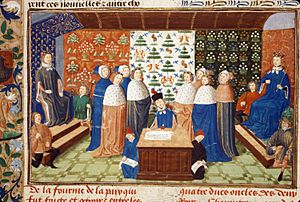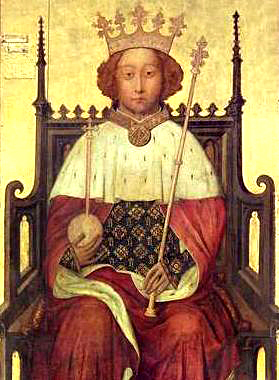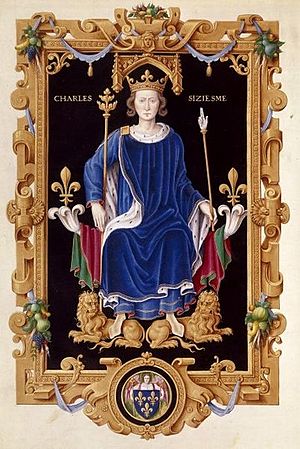Truce of Leulinghem facts for kids
 |
|
| Type | Temporary truce |
|---|---|
| Drafted | June 1389 |
| Signed | June 1389 |
| Effective | 18 July 1389 |
| Condition |
|
| Expiration | Set to expire July 1416; was repudiated in August 1402 |
| Signatories | |
| Parties | |
| Language | French |
The Truce of Leulinghem was a peace agreement made on July 18, 1389. It was signed between King Richard II of England and his allies, and King Charles VI of France and his allies. This truce brought an end to the second part of the long Hundred Years' War.
At this time, England was facing money problems and disagreements within its government. France's King Charles VI was also struggling with a mental illness that made it hard for him to lead the war. Both sides had big problems at home. They knew continuing the war could seriously harm their kingdoms.
The main reason for the war was a disagreement over the Duchy of Aquitaine in France. The King of England ruled this area but was also supposed to be loyal to the King of France for it. Neither side wanted to give up on this point.
Initially, the truce was meant to last for three years. However, the two kings met in person at Leulinghem, a town near the English fortress of Calais. They decided to extend the truce for a much longer period: twenty-seven years!
They also agreed on other important things. They wanted to help end the Papal Schism, which was a split in the Christian church. They planned a joint crusade against the Turks in the Balkans. King Richard also agreed to marry Charles' daughter, Isabella, and received a large payment of 800,000 francs. Both kings promised to keep talking to try and make a lasting peace treaty.
This truce brought peace to the Iberian peninsula too. There, Portugal supported England, and Castile supported France. As part of the agreement, England gave up almost all its lands in northern France, keeping only Calais. This truce led to thirteen years of peace, which was the longest peaceful time during the entire Hundred Years' War.
After the truce, King Richard did not keep his promise to help end the church split. Because of this, France decided to stop supporting either pope and took control of Avignon by force. French foreign policy also started to focus on Italy, and Genoa became a French protectorate.
In England, Richard used this peaceful time to deal with his political enemies. He took their lands and gave them to his friends. Then, he went to Ireland to stop a rebellion. While he was away, his cousin Henry of Bolingbroke returned from exile. Henry started a rebellion and took control of most of England. When Richard came back, he was captured and later died while imprisoned. Henry was then crowned king.
At first, the French thought these events meant the truce was over. They prepared their army. However, King Henry IV confirmed the truce, and it stayed in place for several more years.
Henry made some strong moves against France later on. He married Joanna, the widow of the Duke of Brittany, in April 1402. He also made alliances with German rulers, including a marriage alliance with Bavaria.
The first country to break the truce was Scotland. They invaded England in August 1402, working with a revolt in Wales. France then rejoined the fight in September 1403, sending an army to Wales.
Contents
Why the Truce Happened
The Hundred Years' War began again in 1369. This happened when the French government ended the Treaty of Brétigny from 1360. The war was mainly about the King of England's role. He was both an English king and a French duke, which caused many conflicts. France said the English duchy in southwestern France was lost, starting the war.
England won the first part of the war. The treaty gave England control of the duchy as its own land, separate from France. During the peace that followed, France grew stronger. They decided to take back control of the duchy. For nearly twenty years, France avoided big battles with English armies. Instead, they slowly wore them down. Even though England won some battles, they eventually lost almost all their gains. They kept only a small coastal area of the Duchy of Aquitaine.
By 1389, England was having many political problems. King Richard II wanted peace because the English parliament would not give him enough money for the war. People had also rebelled twice because of high taxes. Also, some nobles, led by his uncle the Duke of Gloucester, tried to take power from him.
France was also in trouble. King Charles VI had repeated mental health issues that made it hard for his government to work. In the 1380s, there were several rebellions in France due to high taxes, starting with the Harelle in 1383. Because of these difficulties, both kingdoms had been trying to make peace for about ten years.
How the Truce Was Negotiated

In June 1389, important diplomats finished talks for a peace treaty. This happened in Leulinghen, a town just outside Calais. England and its allies, Portugal, Ghent, and the Duchy of Guelders, had their representatives there. These included John of Gaunt, Duke of Lancaster, and Thomas of Woodstock, Duke of Gloucester. Both were uncles of King Richard II.
France and its allies, the Kingdom of Castile and the Kingdom of Scotland, were also represented. Their diplomats included Philip the Bold, Duke of Burgundy, and John of Valois, Duke of Berry. These were uncles of King Charles VI. Other regions like the Kingdom of Aragon, parts of the Low Countries, and the Duchy of Brittany had already made peace. They stayed neutral in the conflict. The Holy Roman Empire generally supported England but also remained neutral.
Lower-level diplomats had worked on many treaty details for years before this. France thought England was weaker than it was. So, France offered big concessions. They offered to return almost all of the Duchy of Aquitaine to England. They also let England keep its fortress at Calais. France even offered 1.5 million francs to cover England's losses. In return, the King of England had to agree to show loyalty to the King of France for his duchy. This treaty would have given England back almost everything it lost in the war, except full control of Aquitaine.
Both groups of diplomats went back to their kings for approval. While they waited, a three-year truce was agreed upon. It began on July 18.
The French government was mostly led by the Duke of Burgundy because King Charles VI was often unwell. French approval for the truce came quickly. In England, King Richard's power was not strong. The House of Commons of England in Parliament was mostly controlled by knights who wanted to keep fighting. Richard feared a rebellion if he agreed to the treaty without Parliament's approval. So, he called a meeting to discuss it.
Parliament rejected the treaty. They were worried that if their king showed loyalty to the French king, England would become a lesser kingdom of France. Parliament also refused to approve a large tax increase to keep funding the stalled war.
Richard decided to make peace with France anyway, without a formal treaty. He used this time to deal with his political enemies. On May 15, 1395, he met with French representatives. They agreed that Richard would marry Charles' six-year-old daughter, Isabelle. Charles would provide a payment of 800,000 francs and extend the truce by five years. In return, Richard began leaving the ports he controlled in northern France. He gave up all of them except Calais. Brest and Cherbourg were only given up after local nobles paid large sums of money.
The two kings agreed to meet again later to finish negotiations. However, Charles' mental health remained fragile. He was often not aware of his surroundings. He got a bit better in 1396. The two kings then met privately at Leulinghem for two days. They made several promises. They agreed to a joint crusade against the Turks in the Balkans. Richard also agreed to support France's efforts to end the Papal Schism. He formally accepted Isabelle as his wife and received her payment. The truce was extended for another nineteen years. Both kings agreed to keep working towards a lasting peace. After these talks, both kings went home, and the truce remained in effect.
What Happened Next
After the truce, King Richard started to get back at his political enemies. Several wealthy men were removed from their lands and either executed or sent away. Their property was given to Richard's friends. Richard was trying to create a group of supporters in central England.
Richard failed to send help for the crusade against the Turks. The French army, which included many of France's best fighters, was completely defeated at the Battle of Nicopolis in September 1396. Some of Richard's advisors suggested restarting the war, but he said no. Richard also went back on his promise to help end the church split. He continued to support the Roman pope instead of the Avignon pope. This made France decide to stop supporting either pope and take Avignon by force.
Richard's actions against the nobles caused anger, but it was kept quiet for a while. After John of Gaunt died in 1399, Richard took his lands from his exiled son, Henry of Bolingbroke. Bolingbroke had been living in Paris, where many other exiles started planning to return to England.
Richard left England in 1399 to stop a rebellion in Ireland. While he was away, Henry led a small army back to England. He took back his former lands by force. He quickly gathered an army from other unhappy nobles. He took control of most of England without a fight before Richard could return. When Richard came back, he was forced to give up his throne and later died while imprisoned. Henry was crowned King.
French foreign policy changed after the truce. France started focusing on Italy to try and force the Roman pope to step down. Genoa became a French protectorate. King Charles' mental health continued to get worse. This led to more fighting in the French court. His wife sided with his uncles against Charles' brother, Louis of Orleans.
When Henry became king in England, the French first thought it meant the truce was over. They raised an army and strengthened their defenses. However, French representatives went to England and confirmed the truce with King Henry.
The Truce Ends
Henry made several strong political moves against France in the following years. He married Joan of Navarre, the widow of the Duke of Brittany, in April 1402. This made him duke of two large areas connected to France. France responded by making one of Charles' sons the Duke of Guyenne. This was part of the Duchy of Aquitaine, which France claimed was theirs. Henry also made alliances with several German states, including a marriage alliance with Bavaria.
Scotland was the first country to break the truce. They invaded England in August 1402. This was done with a rebellion in Wales. The Welsh rebellion was probably influenced by the French. France then rejoined the conflict in September 1403, landing an army in Wales. The thirteen-year truce was the longest period of peace between England and France during the Hundred Years' War. The war continued on and off for another fifty years.
See also
- Merciless Parliament English parliament of 1388
Sources


